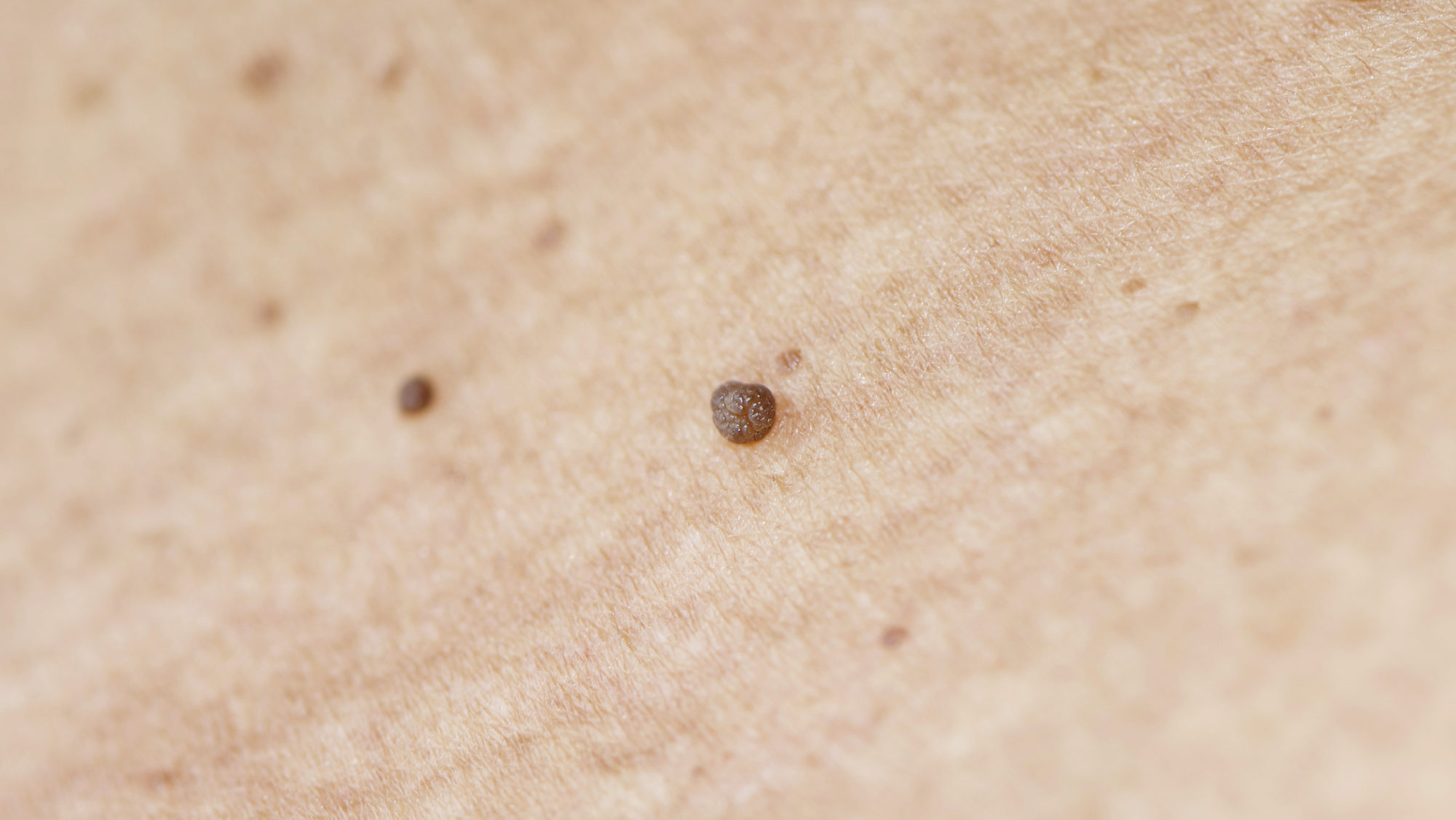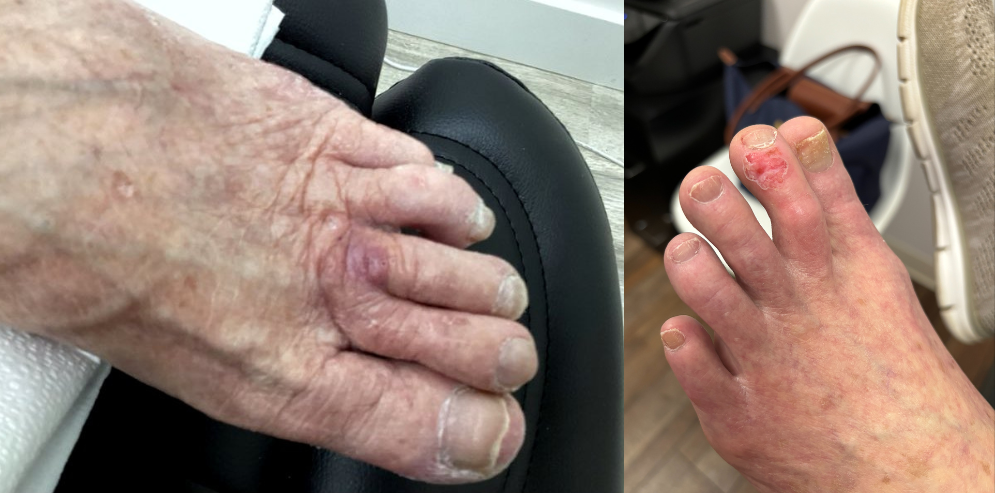
Skin tags are not cancerous, and skin cancer is not usually mistakenly identified as a harmless skin tag. However, it is possible to mistake a cancerous growth for a harmless skin tag, so it’s important to be able to distinguish skin tags vs. skin cancer and respond accordingly. We’ve laid out everything you need to know.
What is a Skin Tag?
You already know that skin tags are harmless, but what is a skin tag? A skin tag is a benign growth composed of collagen and blood vessels. It usually looks like a small cluster of skin extending out from a single point. They don’t require treatment, but some people have them removed for aesthetic reasons.
- What causes skin tags? The ultimate cause is unclear, but they are common in areas where skin rubbing and friction are most common. They are more common in people who have undergone hormonal changes, such as pregnancy, and they are also more common in people who are at least 60 years old.
- Where do skin tags appear? They are most common on the neck, the armpits, the eyelids, the breast area, and the groin. For those who are trying to distinguish skin tags vs. skin cancer, it’s important to note that skin cancer usually appears in other areas with more sun exposure, like the face, scalp, or hands.
Skin Tag or Skin Cancer: What to Keep in Mind
How do you know if a skin tag is cancerous? Skin tags are not cancerous, but any new growth on your body is worthy of deeper investigation. Skin tags are benign growths that typically pose no threat to your health. However, it’s crucial to be vigilant about any new growth on your body, as some skin conditions, including skin cancer, can manifest in ways that may be initially mistaken for harmless skin tags. While skin tags are generally small and present as small flaps of skin, understanding the distinctions between skin tags and skin cancer is essential. Here are key considerations to keep in mind:
1. Size and Appearance:
- Skin Tags: Typically, skin tags are small, ranging from a few millimeters to a centimeter in size. They appear as tiny, soft flaps of skin hanging off the surface.
- Skin Cancer Growth: Skin cancer growths can vary widely in size, and they often present as larger, irregularly shaped lesions on the skin.
2. Attachment to the Skin:
- Skin Tags: These growths are attached to the skin by a thin stalk or peduncle, giving them a distinctive hanging appearance.
- Skin Cancer Growth: Skin cancer tends to spread across the skin surface, lacking the distinct stalk seen in skin tags.
3. Changes Over Time:
- Skin Tags: Skin tags typically remain stable over time. They might grow slightly, but generally do not exhibit rapid changes. If you have a skin tag that changes color, you should see your doctor immediately.
- Skin Cancer Growth: Any growth that undergoes rapid changes in size, shape, or color over a short period may raise concerns and should be evaluated promptly.
4. Coloration:
- Skin Tags: Skin tags usually match the surrounding skin color or may appear slightly darker. If you have a skin tag that changes color, you should see your doctor immediately.
- Skin Cancer Growth: Skin cancer lesions often exhibit uneven coloration, with shades of red, pink, brown, or black. Color changes warrant closer examination.
5. Texture:
- Skin Tags: These growths typically have a smooth and soft texture.
- Skin Cancer Growth: Skin cancer lesions may exhibit irregular borders, asymmetry, and a changing texture, which can include areas that feel rough or scaly.
6. Pain and Itching:
- Skin Tags: Skin tags are generally painless and do not cause itching.
- Skin Cancer Growth: Skin cancer lesions may be accompanied by pain, tenderness, or itching, especially if they become ulcerated or irritated.
7. Location:
- Skin Tags: Commonly found in areas with friction, such as the neck, armpits, or groin.
- Skin Cancer Growth: Can occur anywhere on the body, with a higher likelihood in areas exposed to the sun.
Skin Cancer Prevention: Use the ABCDE Method
You may have heard about the ABCDE method before. It can be especially useful in differentiating skin tags vs. skin cancer. Here is a brief reminder of what to look for when you use the ABCDE method:
- Asymmetry: If you divided the spot down the middle, the two halves would not be matching.
- Border: The spot does not have distinguished edges. Instead, they may be jagged or blurred.
- Color: The spot does not have even coloring throughout. You may see varying shades of pink, red, black, brown, blue, or tan.
- Diameter: The spot is larger than 6 mm, or the size of a pencil eraser.
- Evolving: A spot that shows changes in size, shape, surface texture, or color is cause for concern.
When it comes to skin cancer, prevention and early detection are critical. The ABCDE method can help you track unusual spots on your skin. When you visit a dermatologist, they’ll be able to tell you if you’re dealing with a skin tag or skin cancer.
Consider Image-Guided Superficial Radiotherapy
For diagnoses of common skin cancer, Image-Guided Superficial Radiotherapy (Image-Guided SRT) may be a treatment option. By targeting cancerous cells with radiation, Image-Guided SRT can treat skin cancer without the risk of surgical scarring that comes with Mohs surgery. Find out how it works today.








